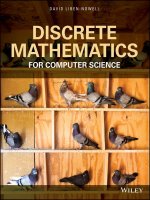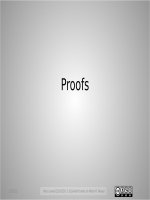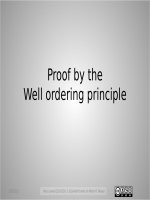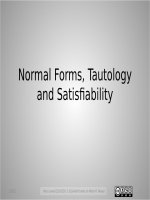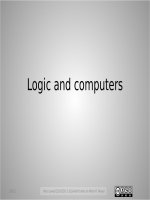Mathematics for computer science
Bạn đang xem bản rút gọn của tài liệu. Xem và tải ngay bản đầy đủ của tài liệu tại đây (7.28 MB, 697 trang )
“mcs” — 2011/5/9 — 20:49 — page i — #1
Mathematics for Computer Science
revised Monday 9th May, 2011, 20:49
Eric Lehman
Google Inc.
F Thomson Leighton
Department of Mathematics and CSAIL, MIT
Akamai Technologies
Albert R Meyer
Massachusets Institute of Technology
Creative Commons
2011, Eric Lehman, F Tom Leighton, Albert R Meyer .
“mcs” — 2011/5/9 — 20:49 — page ii — #2
“mcs” — 2011/5/9 — 20:49 — page iii — #3
Contents
I
Proofs
1
What is a Proof? 7
1.1
1.2
1.3
1.4
1.5
1.6
1.7
1.8
1.9
2
The Well Ordering Principle 25
2.1
2.2
2.3
2.4
3
26
Propositions from Propositions
36
Propositional Logic in Computer Programs
Equivalence and Validity
42
The Algebra of Propositions
44
The SAT Problem
49
Predicate Formulas
50
Mathematical Data Types 67
4.1
4.2
4.3
4.4
5
Well Ordering Proofs
25
Template for Well Ordering Proofs
Summing the Integers
26
Factoring into Primes
28
Logical Formulas 35
3.1
3.2
3.3
3.4
3.5
3.6
4
Propositions
7
Predicates
9
The Axiomatic Method
10
Our Axioms
11
Proving an Implication
13
Proving an “If and Only If”
15
Proof by Cases
17
Proof by Contradiction
18
Good Proofs in Practice
19
Sets
67
Sequences
70
Functions
71
Binary Relations
73
Infinite Sets 87
5.1
5.2
5.3
5.4
Finite Cardinality
88
Infinite Cardinality
90
The Halting Problem
95
The Logic of Sets
98
39
“mcs” — 2011/5/9 — 20:49 — page iv — #4
iv
Contents
5.5
6
Ordinary Induction 113
State Machines 122
Strong Induction 134
Strong Induction vs. Induction vs. Well Ordering
138
Recursive Data Types 159
7.1
7.2
7.3
7.4
7.5
8
101
Induction 113
6.1
6.2
6.3
6.4
7
Does All This Really Work?
Recursive Definitions and Structural Induction 159
Strings of Matched Brackets 163
Recursive Functions on Nonnegative Integers 166
Arithmetic Expressions 169
Induction in Computer Science 174
Number Theory 183
8.1
8.2
8.3
8.4
8.5
8.6
8.7
8.8
8.9
Divisibility 183
The Greatest Common Divisor 189
The Fundamental Theorem of Arithmetic 195
Alan Turing 197
Modular Arithmetic 201
Arithmetic with a Prime Modulus 204
Arithmetic with an Arbitrary Modulus 209
The RSA Algorithm 214
What has SAT got to do with it? 216
II Structures
9
Directed graphs & Partial Orders 233
9.1
9.2
9.3
9.4
9.5
9.6
9.7
9.8
9.9
9.10
9.11
Digraphs & Vertex Degrees 235
Digraph Walks and Paths 236
Adjacency Matrices 239
Path Relations 242
Directed Acyclic Graphs & Partial Orders 243
Weak Partial Orders 246
Representing Partial Orders by Set Containment
Path-Total Orders 248
Product Orders 249
Scheduling 250
Equivalence Relations 256
247
“mcs” — 2011/5/9 — 20:49 — page v — #5
v
Contents
9.12 Summary of Relational Properties
257
10 Communication Networks 279
10.1
10.2
10.3
10.4
10.5
10.6
10.7
10.8
10.9
Complete Binary Tree 279
Routing Problems 279
Network Diameter 280
Switch Count 281
Network Latency 282
Congestion 282
2-D Array 283
Butterfly 285
Bene˘s Network 287
11 Simple Graphs 299
11.1 Vertex Adjacency and Degrees 299
11.2 Sexual Demographics in America 301
11.3 Some Common Graphs 303
11.4 Isomorphism 305
11.5 Bipartite Graphs & Matchings 307
11.6 The Stable Marriage Problem 312
11.7 Coloring 319
11.8 Getting from u to v in a Graph 324
11.9 Connectivity 325
11.10 Odd Cycles and 2-Colorability 329
11.11 Forests & Trees 330
12 Planar Graphs 361
12.1
12.2
12.3
12.4
12.5
12.6
12.7
12.8
Drawing Graphs in the Plane 361
Definitions of Planar Graphs 361
Euler’s Formula 371
Bounding the Number of Edges in a Planar Graph
Returning to K5 and K3;3 373
Another Characterization for Planar Graphs 374
Coloring Planar Graphs 375
Classifying Polyhedra 377
13 State Machines 387
13.1 The Alternating Bit Protocol 387
13.2 Reasoning About While Programs 390
372
“mcs” — 2011/5/9 — 20:49 — page vi — #6
vi
Contents
III Counting
14 Sums and Asymptotics 401
14.1
14.2
14.3
14.4
14.5
14.6
14.7
The Value of an Annuity 402
Sums of Powers 408
Approximating Sums 410
Hanging Out Over the Edge 414
Products 426
Double Trouble 428
Asymptotic Notation 431
15 Cardinality Rules 449
15.1 Counting One Thing by Counting Another
15.2 Counting Sequences 450
15.3 The Generalized Product Rule 453
15.4 The Division Rule 457
15.5 Counting Subsets 460
15.6 Sequences with Repetitions 461
15.7 The Binomial Theorem 463
15.8 A Word about Words 465
15.9 Counting Practice: Poker Hands 465
15.10 Inclusion-Exclusion 470
15.11 Combinatorial Proofs 476
15.12 The Pigeonhole Principle 479
15.13 A Magic Trick 484
IV Probability
16 Events and Probability Spaces 515
16.1
16.2
16.3
16.4
16.5
16.6
16.7
Let’s Make a Deal 515
The Four Step Method 516
Strange Dice 525
Set Theory and Probability 533
Conditional Probability 537
Independence 549
The Birthday Principle 555
17 Random Variables 573
17.1 Random Variable Examples
573
449
“mcs” — 2011/5/9 — 20:49 — page vii — #7
vii
Contents
17.2
17.3
17.4
17.5
Independence 575
Distribution Functions 576
Great Expectations 585
Linearity of Expectation 597
18 Deviation from the Mean 617
18.1
18.2
18.3
18.4
18.5
18.6
18.7
18.8
Why the Mean? 617
Markov’s Theorem 618
Chebyshev’s Theorem 620
Properties of Variance 624
Estimation by Random Sampling 628
Confidence versus Probability 633
Sums of Random Variables 634
Really Great Expectations 644
19 Random Processes 661
19.1 Gamblers’ Ruin 661
19.2 Random Walks on Graphs
Index 678
667
“mcs” — 2011/5/9 — 20:49 — page viii — #8
“mcs” — 2011/5/9 — 20:49 — page 1 — #9
I
Proofs
“mcs” — 2011/5/9 — 20:49 — page 2 — #10
“mcs” — 2011/5/9 — 20:49 — page 3 — #11
Introduction
This text explains how to use mathematical models and methods to analyze problems that arise in computer science. Proofs play a central role in this work because
the authors share a belief with most mathematicians that proofs are essential for
genuine understanding. Proofs also play a growing role in computer science; they
are used to certify that software and hardware will always behave correctly, something that no amount of testing can do.
Simply put, a proof is a method of establishing truth. Like beauty, “truth” sometimes depends on the eye of the beholder, and it should not be surprising that what
constitutes a proof differs among fields. For example, in the judicial system, legal
truth is decided by a jury based on the allowable evidence presented at trial. In the
business world, authoritative truth is specified by a trusted person or organization,
or maybe just your boss. In fields such as physics or biology, scientific truth1 is
confirmed by experiment. In statistics, probable truth is established by statistical
analysis of sample data.
Philosophical proof involves careful exposition and persuasion typically based
on a series of small, plausible arguments. The best example begins with “Cogito
ergo sum,” a Latin sentence that translates as “I think, therefore I am.” It comes
from the beginning of a 17th century essay by the mathematician/philosopher, Ren´e
Descartes, and it is one of the most famous quotes in the world: do a web search
on the phrase and you will be flooded with hits.
Deducing your existence from the fact that you’re thinking about your existence
is a pretty cool and persuasive-sounding idea. However, with just a few more lines
1 Actually, only scientific falsehood
can be demonstrated by an experiment—when the experiment
fails to behave as predicted. But no amount of experiment can confirm that the next experiment won’t
fail. For this reason, scientists rarely speak of truth, but rather of theories that accurately predict past,
and anticipated future, experiments.
“mcs” — 2011/5/9 — 20:49 — page 4 — #12
4
Part I
Proofs
of argument in this vein, Descartes goes on to conclude that there is an infinitely
beneficent God. Whether or not you believe in an infinitely beneficent God, you’ll
probably agree that any very short “proof” of God’s infinite beneficence is bound
to be far-fetched. So even in masterful hands, this approach is not reliable.
Mathematics has its own specific notion of “proof.”
Definition. A mathematical proof of a proposition is a chain of logical deductions
leading to the proposition from a base set of axioms.
The three key ideas in this definition are highlighted: proposition, logical deduction, and axiom. In the next Chapter, we’ll discuss these three ideas along with
some basic ways of organizing proofs.
Problems for Section 0.0
Class Problems
Problem 0.1.
Identify exactly where the bugs are in each of the following bogus proofs.2
(a) Bogus Claim: 1=8 > 1=4:
Bogus proof.
3>2
3 log10 .1=2/ > 2 log10 .1=2/
log10 .1=2/3 > log10 .1=2/2
.1=2/3 > .1=2/2 ;
and the claim now follows by the rules for multiplying fractions.
(b) Bogus proof : 1¢ D $0:01 D .$0:1/2 D .10¢/2 D 100¢ D $1:
(c) Bogus Claim: If a and b are two equal real numbers, then a D 0.
2 From Stueben, Michael and Diane Sandford. Twenty Years Before the Blackboard, Mathematical
Association of America, ©1998.
“mcs” — 2011/5/9 — 20:49 — page 5 — #13
5
Part I
Proofs
Bogus proof.
aDb
a2 D ab
a2
.a
b 2 D ab
b2
b/.a C b/ D .a
b/b
aCb Db
a D 0:
Problem 0.2.
It’s a fact that the Arithmetic Mean is at least as large the Geometric Mean, namely,
aCb
2
p
ab
for all nonnegative real numbers a and b. But there’s something objectionable
about the following proof of this fact. What’s the objection, and how would you fix
it?
Bogus proof.
aCb
2
aCb
a2 C 2ab C b 2
a2
2ab C b 2
.a
2
b/
‹
p
ab;
so
‹
p
2 ab;
so
4ab;
so
0;
so
0
which we know is true.
‹
‹
The last statement is true because a b is a real number, and the square of a real
number is never negative. This proves the claim.
Problem 0.3.
Albert announces to his class that he plans to surprise them with a quiz sometime
next week.
“mcs” — 2011/5/9 — 20:49 — page 6 — #14
6
Part I
Proofs
His students first wonder if the quiz could be on Friday of next next. They
reason that it can’t: if Albert didn’t give the quiz before Friday, then by midnight
Thursday, they would know the quiz had to be on Friday, and so the quiz wouldn’t
be a surprise any more.
Next the students wonder whether Albert could give the surprise quiz Thursday.
They observe that if the quiz wasn’t given before Thursday, it would have to be
given on the Thursday, since they already know it can’t be given on Friday. But
having figured that out, it wouldn’t be a surprise if the quiz was on Thursday either.
Similarly, the students reason that the quiz can’t be on Wednesday, Tuesday, or
Monday. Namely, it’s impossible for Albert to give a surprise quiz next week. All
the students now relax, having concluded that Albert must have been bluffing.
And since no one expects the quiz, that’s why, when Albert gives it on Tuesday
next week, it really is a surprise!
What do you think is wrong with the students’ reasoning?
“mcs” — 2011/5/9 — 20:49 — page 7 — #15
1
1.1
What is a Proof?
Propositions
Definition. A proposition is a statement that is either true or false.
For example, both of the following statements are propositions. The first is true
and the second is false.
Proposition 1.1.1. 2 + 3 = 5.
Proposition 1.1.2. 1 + 1 = 3.
Being true or false doesn’t sound like much of a limitation, but it does exclude
statements such as, “Wherefore art thou Romeo?” and “Give me an A!”. It also excludes statements whose truth varies with circumstance such as, “It’s five o’clock,”
or “the stock market will rise tomorrow.”
Unfortunately it is not always easy to decide if a proposition is true or false:
Proposition 1.1.3. For every nonnegative integer, n, the value of n2 C n C 41 is
prime.
(A prime is an integer greater than one that is not divisible by any other integer
greater than 1, for example, 2, 3, 5, 7, 11, . . . .) Let’s try some numerical experimentation to check this proposition. Let 1
p.n/ WWD n2 C n C 41:
(1.1)
We begin with p.0/ D 41 which is prime; then
p.1/ D 43; p.2/ D 47; p.3/ D 53; : : : ; p.20/ D 461
are each prime. Hmmm, starts to look like a plausible claim. In fact we can keep
checking through n D 39 and confirm that p.39/ D 1601 is prime.
But p.40/ D 402 C 40 C 41 D 41 41, which is not prime. So it’s not true that
the expression is prime for all nonnegative integers. In fact, it’s not hard to show
that no polynomial with integer coefficients can map all natural numbers into prime
numbers, unless it’s a constant (see Problem 1.4). The point is that in general you
1 The
symbol WWD means “equal by definition.” It’s always ok simply to write “=” instead of WWD,
but reminding the reader that an equality holds by definition can be helpful.
“mcs” — 2011/5/9 — 20:49 — page 8 — #16
8
Chapter 1
What is a Proof?
can’t check a claim about an infinite set by checking a finite set of its elements, no
matter how large the finite set.
By the way, propositions like this about all numbers or all items of some kind
are so common that there is a special notation for them. With this notation, Proposition 1.1.3 would be
8n 2 N: p.n/ is prime:
(1.2)
Here the symbol 8 is read “for all”. The symbol N stands for the set of nonnegative
integers, namely, 0, 1, 2, 3, . . . (ask your instructor for the complete list). The
symbol “2” is read as “is a member of,” or “belongs to,” or simply as “is in”. The
period after the N is just a separator between phrases.
Here are two even more extreme examples:
Proposition 1.1.4. [Euler’s Conjecture] The equation
a4 C b 4 C c 4 D d 4
has no solution when a; b; c; d are positive integers.
Euler (pronounced “oiler”) conjectured this in 1769. But the proposition was
proven false 218 years later by Noam Elkies at a liberal arts school up Mass Ave.
The solution he found was a D 95800; b D 217519; c D 414560; d D 422481.
In logical notation, Euler’s Conjectured could be written,
8a 2 ZC 8b 2 ZC 8c 2 ZC 8d 2 ZC : a4 C b 4 C c 4 ¤ d 4 :
Here, ZC is a symbol for the positive integers. Strings of 8’s like this are usually
abbreviated for easier reading:
8a; b; c; d 2 ZC : a4 C b 4 C c 4 ¤ d 4 :
Proposition 1.1.5. 313.x 3 C y 3 / D z 3 has no solution when x; y; z 2 ZC .
This proposition is also false, but the smallest counterexample has more than
1000 digits!
Proposition 1.1.6. Every map can be colored with 4 colors so that adjacent2 regions have different colors.
2 Two
regions are adjacent only when they share a boundary segment of positive length. They are
not considered to be adjacent if their boundaries meet only at a few points.
“mcs” — 2011/5/9 — 20:49 — page 9 — #17
1.2. Predicates
9
This proposition is true and is known as the “Four-Color Theorem”. However,
there have been many incorrect proofs, including one that stood for 10 years in
the late 19th century before the mistake was found. A laborious proof was finally
found in 1976 by mathematicians Appel and Haken, who used a complex computer
program to categorize the four-colorable maps; the program left a few thousand
maps uncategorized, and these were checked by hand by Haken and his assistants—
including his 15-year-old daughter. There was a lot of debate about whether this
was a legitimate proof: the proof was too big to be checked without a computer,
and no one could guarantee that the computer calculated correctly, nor did anyone
have the energy to recheck the four-colorings of thousands of maps that were done
by hand. Within the past decade a mostly intelligible proof of the Four-Color Theorem was found, though a computer is still needed to check colorability of several
hundred special maps. 3
Proposition 1.1.7 (Goldbach’s Conjecture). Every even integer greater than 2 is
the sum of two primes.
Goldbach’s Conjecture dates back to 1742, and to this day, no one knows whether
it’s true or false.
For a computer scientist, some of the most important things to prove are the
correctness of programs and systems—whether a program or system does what it’s
supposed to. Programs are notoriously buggy, and there’s a growing community
of researchers and practitioners trying to find ways to prove program correctness.
These efforts have been successful enough in the case of CPU chips that they are
now routinely used by leading chip manufacturers to prove chip correctness and
avoid mistakes like the notorious Intel division bug in the 1990’s.
Developing mathematical methods to verify programs and systems remains an
active research area. We’ll illustrate some of these methods in Chapter 6.
1.2
Predicates
A predicate is a proposition whose truth depends on the value of one or more variables. Most of the propositions above were defined in terms of predicates. For
example,
“n is a perfect square”
3 The story of the Four-Color Proof is told in a well-reviewed popular (non-technical) book: “Four
Colors Suffice. How the Map Problem was Solved.” Robin Wilson. Princeton Univ. Press, 2003,
276pp. ISBN 0-691-11533-8.
“mcs” — 2011/5/9 — 20:49 — page 10 — #18
10
Chapter 1
What is a Proof?
is a predicate whose truth depends on the value of n. The predicate is true for n D 4
since four is a perfect square, but false for n D 5 since five is not a perfect square.
Like other propositions, predicates are often named with a letter. Furthermore, a
function-like notation is used to denote a predicate supplied with specific variable
values. For example, we might name our earlier predicate P :
P .n/ WWD “n is a perfect square”:
So P .4/ is true, and P .5/ is false.
This notation for predicates is confusingly similar to ordinary function notation.
If P is a predicate, then P .n/ is either true or false, depending on the value of n.
On the other hand, if p is an ordinary function, like n2 C1, then p.n/ is a numerical
quantity. Don’t confuse these two!
1.3
The Axiomatic Method
The standard procedure for establishing truth in mathematics was invented by Euclid, a mathematician working in Alexandria, Egypt around 300 BC. His idea was
to begin with five assumptions about geometry, which seemed undeniable based on
direct experience. (For example, “There is a straight line segment between every
pair of points.) Propositions like these that are simply accepted as true are called
axioms.
Starting from these axioms, Euclid established the truth of many additional propositions by providing “proofs”. A proof is a sequence of logical deductions from
axioms and previously-proved statements that concludes with the proposition in
question. You probably wrote many proofs in high school geometry class, and
you’ll see a lot more in this text.
There are several common terms for a proposition that has been proved. The
different terms hint at the role of the proposition within a larger body of work.
Important propositions are called theorems.
A lemma is a preliminary proposition useful for proving later propositions.
A corollary is a proposition that follows in just a few logical steps from a
theorem.
The definitions are not precise. In fact, sometimes a good lemma turns out to be far
more important than the theorem it was originally used to prove.
“mcs” — 2011/5/9 — 20:49 — page 11 — #19
1.4. Our Axioms
11
Euclid’s axiom-and-proof approach, now called the axiomatic method, remains
the foundation for mathematics today. In fact, just a handful of axioms, called the
axioms Zermelo-Frankel with Choice (ZFC), together with a few logical deduction
rules, appear to be sufficient to derive essentially all of mathematics. We’ll examine
these in Chapter 4.
1.4
Our Axioms
The ZFC axioms are important in studying and justifying the foundations of mathematics, but for practical purposes, they are much too primitive. Proving theorems
in ZFC is a little like writing programs in byte code instead of a full-fledged programming language—by one reckoning, a formal proof in ZFC that 2 C 2 D 4
requires more than 20,000 steps! So instead of starting with ZFC, we’re going to
take a huge set of axioms as our foundation: we’ll accept all familiar facts from
high school math!
This will give us a quick launch, but you may find this imprecise specification
of the axioms troubling at times. For example, in the midst of a proof, you may
find yourself wondering, “Must I prove this little fact or can I take it as an axiom?”
There really is no absolute answer, since what’s reasonable to assume and what
requires proof depends on the circumstances and the audience. A good general
guideline is Just to be up front about what you’re assuming, and don’t try to evade
needed work by declaring everything an axiom!
1.4.1
Logical Deductions
Logical deductions or inference rules are used to prove new propositions using
previously proved ones.
A fundamental inference rule is modus ponens. This rule says that a proof of P
together with a proof that P IMPLIES Q is a proof of Q.
Inference rules are sometimes written in a funny notation. For example, modus
ponens is written:
Rule.
P;
P IMPLIES Q
Q
When the statements above the line, called the antecedents, are proved, then we
can consider the statement below the line, called the conclusion or consequent, to
also be proved.
“mcs” — 2011/5/9 — 20:49 — page 12 — #20
12
Chapter 1
What is a Proof?
A key requirement of an inference rule is that it must be sound: an assignment
of truth values to the letters, P , Q, . . . , that makes all the antecedents true must
also make the consequent true. So if we start off with true axioms and apply sound
inference rules, everything we prove will also be true.
There are many other natural, sound inference rules, for example:
Rule.
P IMPLIES Q; Q IMPLIES R
P IMPLIES R
Rule.
NOT .P / IMPLIES NOT .Q/
Q IMPLIES P
On the other hand,
Rule.
NOT .P / IMPLIES NOT .Q/
P IMPLIES Q
is not sound: if P is assigned T and Q is assigned F, then the antecedent is true
and the consequent is not.
Note that a propositional inference rule is sound precisely when the conjunction
(AND) of all its antecedents implies its consequent.
As with axioms, we will not be too formal about the set of legal inference rules.
Each step in a proof should be clear and “logical”; in particular, you should state
what previously proved facts are used to derive each new conclusion.
1.4.2
Patterns of Proof
In principle, a proof can be any sequence of logical deductions from axioms and
previously proved statements that concludes with the proposition in question. This
freedom in constructing a proof can seem overwhelming at first. How do you even
start a proof?
Here’s the good news: many proofs follow one of a handful of standard templates. Each proof has it own details, of course, but these templates at least provide
you with an outline to fill in. We’ll go through several of these standard patterns,
pointing out the basic idea and common pitfalls and giving some examples. Many
of these templates fit together; one may give you a top-level outline while others
help you at the next level of detail. And we’ll show you other, more sophisticated
proof techniques later on.
The recipes below are very specific at times, telling you exactly which words to
write down on your piece of paper. You’re certainly free to say things your own
“mcs” — 2011/5/9 — 20:49 — page 13 — #21
1.5. Proving an Implication
13
way instead; we’re just giving you something you could say so that you’re never at
a complete loss.
1.5
Proving an Implication
Propositions of the form “If P , then Q” are called implications. This implication
is often rephrased as “P IMPLIES Q.”
Here are some examples:
(Quadratic Formula) If ax 2 C bx C c D 0 and a ¤ 0, then
Á
p
xD
b ˙ b 2 4ac =2a:
(Goldbach’s Conjecture) If n is an even integer greater than 2, then n is a
sum of two primes.
If 0 Ä x Ä 2, then x 3 C 4x C 1 > 0.
There are a couple of standard methods for proving an implication.
1.5.1
Method #1
In order to prove that P IMPLIES Q:
1. Write, “Assume P .”
2. Show that Q logically follows.
Example
Theorem 1.5.1. If 0 Ä x Ä 2, then x 3 C 4x C 1 > 0.
Before we write a proof of this theorem, we have to do some scratchwork to
figure out why it is true.
The inequality certainly holds for x D 0; then the left side is equal to 1 and
1 > 0. As x grows, the 4x term (which is positive) initially seems to have greater
magnitude than x 3 (which is negative). For example, when x D 1, we have
4x D 4, but x 3 D 1 only. In fact, it looks like x 3 doesn’t begin to dominate
until x > 2. So it seems the x 3 C 4x part should be nonnegative for all x between
0 and 2, which would imply that x 3 C 4x C 1 is positive.
“mcs” — 2011/5/9 — 20:49 — page 14 — #22
14
Chapter 1
What is a Proof?
So far, so good. But we still have to replace all those “seems like” phrases with
solid, logical arguments. We can get a better handle on the critical x 3 C 4x part
by factoring it, which is not too hard:
x 3 C 4x D x.2
x/.2 C x/
Aha! For x between 0 and 2, all of the terms on the right side are nonnegative. And
a product of nonnegative terms is also nonnegative. Let’s organize this blizzard of
observations into a clean proof.
Proof. Assume 0 Ä x Ä 2. Then x, 2 x, and 2Cx are all nonnegative. Therefore,
the product of these terms is also nonnegative. Adding 1 to this product gives a
positive number, so:
x.2 x/.2 C x/ C 1 > 0
Multiplying out on the left side proves that
x 3 C 4x C 1 > 0
as claimed.
There are a couple points here that apply to all proofs:
You’ll often need to do some scratchwork while you’re trying to figure out
the logical steps of a proof. Your scratchwork can be as disorganized as you
like—full of dead-ends, strange diagrams, obscene words, whatever. But
keep your scratchwork separate from your final proof, which should be clear
and concise.
Proofs typically begin with the word “Proof” and end with some sort of
doohickey like or “q.e.d”. The only purpose for these conventions is to
clarify where proofs begin and end.
1.5.2
Method #2 - Prove the Contrapositive
An implication (“P IMPLIES Q”) is logically equivalent to its contrapositive
NOT .Q/ IMPLIES NOT .P / :
Proving one is as good as proving the other, and proving the contrapositive is sometimes easier than proving the original statement. If so, then you can proceed as
follows:
1. Write, “We prove the contrapositive:” and then state the contrapositive.
2. Proceed as in Method #1.
“mcs” — 2011/5/9 — 20:49 — page 15 — #23
1.6. Proving an “If and Only If”
15
Example
Theorem 1.5.2. If r is irrational, then
p
r is also irrational.
A number is rational when it equals a quotient of integers, that is, if it equals
m=n for some integers m and n. If it’s not rational, then it’s called irrational. So
p
we must show that if r is not a ratio of integers, then r is also not a ratio of
integers. That’s pretty convoluted! We can eliminate both not’s and make the proof
straightforward by using the contrapositive instead.
p
Proof. We prove the contrapositive: if r is rational, then r is rational.
p
Assume that r is rational. Then there exist integers m and n such that:
p
m
rD
n
Squaring both sides gives:
m2
rD 2
n
2
2
Since m and n are integers, r is also rational.
1.6
Proving an “If and Only If”
Many mathematical theorems assert that two statements are logically equivalent;
that is, one holds if and only if the other does. Here is an example that has been
known for several thousand years:
Two triangles have the same side lengths if and only if two side lengths
and the angle between those sides are the same.
The phrase “if and only if” comes up so often that it is often abbreviated “iff”.
1.6.1
Method #1: Prove Each Statement Implies the Other
The statement “P IFF Q” is equivalent to the two statements “P IMPLIES Q” and
“Q IMPLIES P ”. So you can prove an “iff” by proving two implications:
1. Write, “We prove P implies Q and vice-versa.”
2. Write, “First, we show P implies Q.” Do this by one of the methods in
Section 1.5.
3. Write, “Now, we show Q implies P .” Again, do this by one of the methods
in Section 1.5.
“mcs” — 2011/5/9 — 20:49 — page 16 — #24
16
Chapter 1
1.6.2
What is a Proof?
Method #2: Construct a Chain of Iffs
In order to prove that P is true iff Q is true:
1. Write, “We construct a chain of if-and-only-if implications.”
2. Prove P is equivalent to a second statement which is equivalent to a third
statement and so forth until you reach Q.
This method sometimes requires more ingenuity than the first, but the result can be
a short, elegant proof.
Example
The standard deviation of a sequence of values x1 ; x2 ; : : : ; xn is defined to be:
s
.x1
/2 C .x2
/2 C C .xn
/2
(1.3)
n
where
is the mean of the values:
x1 C x2 C C xn
WWD
n
Theorem 1.6.1. The standard deviation of a sequence of values x1 ; : : : ; xn is zero
iff all the values are equal to the mean.
For example, the standard deviation of test scores is zero if and only if everyone
scored exactly the class average.
Proof. We construct a chain of “iff” implications, starting with the statement that
the standard deviation (1.3) is zero:
s
.x1
/2 C .x2
/2 C C .xn
/2
D 0:
(1.4)
n
Now since zero is the only number whose square root is zero, equation (1.4) holds
iff
.x1
/2 C .x2
/2 C C .xn
/2 D 0:
(1.5)
Now squares of real numbers are always nonnegative, so every term on the left
hand side of equation (1.5) is nonnegative. This means that (1.5) holds iff
Every term on the left hand side of (1.5) is zero.
But a term .xi
/2 is zero iff xi D , so (1.6) is true iff
Every xi equals the mean.
(1.6)
“mcs” — 2011/5/9 — 20:49 — page 17 — #25
1.7. Proof by Cases
1.7
17
Proof by Cases
Breaking a complicated proof into cases and proving each case separately is a useful, common proof strategy. Here’s an amusing example.
Let’s agree that given any two people, either they have met or not. If every pair
of people in a group has met, we’ll call the group a club. If every pair of people in
a group has not met, we’ll call it a group of strangers.
Theorem. Every collection of 6 people includes a club of 3 people or a group of 3
strangers.
Proof. The proof is by case analysis4 . Let x denote one of the six people. There
are two cases:
1. Among 5 other people besides x, at least 3 have met x.
2. Among the 5 other people, at least 3 have not met x.
Now we have to be sure that at least one of these two cases must hold,5 but that’s
easy: we’ve split the 5 people into two groups, those who have shaken hands with
x and those who have not, so one the groups must have at least half the people.
Case 1: Suppose that at least 3 people did meet x.
This case splits into two subcases:
Case 1.1: No pair among those people met each other. Then these
people are a group of at least 3 strangers. So the Theorem holds in this
subcase.
Case 1.2: Some pair among those people have met each other. Then
that pair, together with x, form a club of 3 people. So the Theorem
holds in this subcase.
This implies that the Theorem holds in Case 1.
Case 2: Suppose that at least 3 people did not meet x.
This case also splits into two subcases:
4 Describing
your approach at the outset helps orient the reader.
of a case analysis argument is showing that you’ve covered all the cases. Often this is
obvious, because the two cases are of the form “P ” and “not P ”. However, the situation above is not
stated quite so simply.
5 Part

